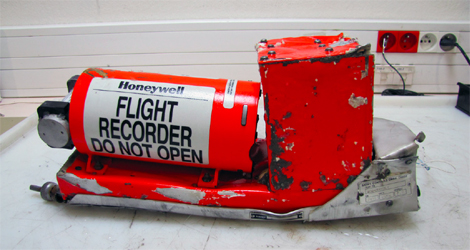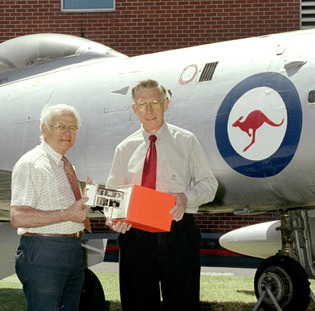Digital Flight Recorders
A flight data recorder, Lütticke, DW.
Anatomical Breakdown of a Black Box
The anatomy of a black box, labeled inside and out, Britannica.
Flight recorders are created to endure incredible conditions, and are therefore encased in a thin layer of aluminum, an inch of insulation, as well as a stainless steel or titanium shell that is corrosion resistant. A standard black box weighs only about 10 pounds. They are capable of withstanding up to 3400 Gs, 2000 degrees fahrenheit for up to 60 minutes, penetration force of 500 pounds, and submersion in 20,000 feet of saltwater for 30 days, over which a sound pings once per second. Due to all of these factors, it is very rare for a black box to be destroyed in a crash.
Aesthetically, black boxes are not representative of their name. In order to be spotted by overhead search aircrafts, they are painted in a fluorescent red-orange color! No one knows for sure why it’s called a “black box,” but one explanation is that in 1939, Francois Hussenot, an aviation engineer, created a way to capture an airplane’s history onto film, which required total darkness for it to work.

A black box from the Air France flight AF440, Aviation Accidents.

NTSB workers recovering a black box from an accident site in Anahuac, Texas, KHOU.
Development of the Black Box
In 1949, a British aviation firm, De Havilland, launched a new aircraft, the Comet. This was the world’s first jet airliner, and was met with admiration from the public. However, a series of 7 fatal accidents from 1952-1954 caused the unexplained deaths of 110 individuals. A lack of witnesses, survivors, and raw data caused the Aeronautical Research Laboratories to search for answers in how to prevent future accidents. In response to these accidents, researcher David Warren developed a device to record cockpit noise and instruments during flight. The concept of the black box was born, and a prototype, initially called a “flight memory unit” was developed in 1957. This device consisted of a steel foil that recorded up to four hours of flight data.
Following a plane crash in Queensland in 1960, the Australian government became the first to require all of the nation’s commercial aircrafts to carry a recording device. Today, all major aircraft are required to have voice and data recorders, helping solve airplane crashes and aid in aircraft safety training.

Daivd Warren (left) and Ken Fraser, Australian Government Department of Defence.
“In investigating accidents... anything which provides a record of flight conditions, pilot reactions, etc. for the few moments preceding the crash is of inestimable value.”
~Dr. David Warren, 1954